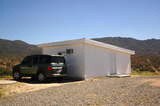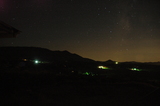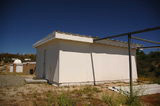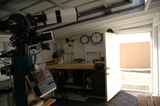|
Click on images to enlarge
After a multi-year planning and construction effort, I now have a permanent observatory on the site of the Orange County Astronomers (OCA) Anza observing site at about 4300 ft. elevation only a dozen miles from Caltech's Palomar Observatory. It takes about 2 hours to get to it from my home.
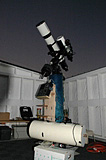
The instrument setup consists of a Losmandy Titan mount carrying a side-by-side saddle. One side holds a Borg 100ED or Borg 125EDF2.8 for 6x9 and 4x5 photography along with a Mini-Borg 45ED and SBIG STV guider plus 50mm finder and red-dot pointer. 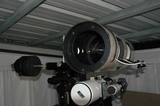
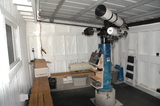
The second saddle position holds an Astro-physics 155EDF for 6x7 photography, a 200mm Schmidt camera for 6x6cm photography, or any other scope/camera which can be mounted on a Losmandy-compatible dovetail plate. A C11 can also replace the double-saddle setups for visual applications or video photography. The telescope pier is isolated from the building slab by a foam-filled gap. The height is a bit higher than would be normally chosen for open-air use, but was specifically calculated to give the scopes a low horizon in the directions most favorable for viewing, yet still allow walls to be high enough to block a direct view of neighboring lights by someone walking around the scopes.
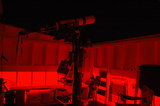
Red LED's are used for indirect lighting when long exposure imaging is not in progress. Walls in the observing area are open 2x6 studs on the inside to minimize cool-down time in the evening. The exterior of the entire observatory is painted white to minimize daytime heating by the sun. 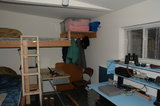
The warming room is heavily insulated, and due to the building orientation is minimally exposed to direct sunlight in the afternoon. It includes a window to the observing area but is also cabled to the scope to allow for monitoring the autoguider or remote control of the mount. An 802.11b wireless network provided by the OCA allows for web and email access via the club's satellite internet link too -- all the conveniences of home except for plumbing, which is provided by the club in the nearby club house (Anza House)! In 2011, the wireless network was augmented with fiber optic connections between the private observatories and the satellite connection, improving the connection reliability and speed of the intranet. Two member observatories are also now feeding their sky condition monitoring data to a server for both on-site monitoring by all members and off-site access by members planning trips to the OCA site. I am very grateful to the OCA for providing the site and infrastructure to support the observatory, and numerous club members -- especially Gary Schones and James Thorp, for their support, advice, and labor without which this project would not have been possible. I also want to thank my wife Jean not only for support and encouragement but also active participation in the design and construction of the observatory! |
 |

|
Vanishing Point Observatory |
